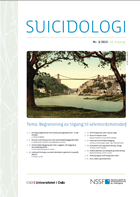Irrational thinking in suicidal individuals: a general or a specific deficit?
DOI:
https://doi.org/10.5617/suicidologi.2220Abstract
Theories of the irrational thinking in suicidal individual are reviewed, and a battery of inventories was given to a nonclinical sample of students to explore whether there is a general tendency to think irrationally on all measures. Scores on tests of hopelessness, helplessness, defeat, entrapment, self-esteem, burdensomeness, perseverative thinking, rumination and thinking that one is an impostor were all strongly intercorreated and associated with depression scores and past suicidal ideation, indicating that irrational thinking in suicidal individuals is a general deficit. Teorier om irrasjonell tenkning blir først gjennomgått. Artikkelen redegjør for en undersøkelse der en gruppe studenter ble bedt om å fylle ut et sett med spørreskjemaer, for å undersøke om det er en generell tendens til å tenke irrasjonelt. Skårer for håpløshet, hjelpeløshet, opplevelse av nederlag, å føle seg fanget, selvfølelse, følelse av å være til bry, persevererende tenkning, grubling og tanker om at man er en bedrager var alle sterkt interkorrelert og hang sammen med skårer på depresjon og tidligere selvmordstanker – noe som indikerer at irrasjonell tenkning hos suicidale personer er en generell sårbarhetsfaktor.Referenser
Beck, A. T. (1976). Cognitive therapy and emotional
disorders. New York: International Universities Press.
Beck, A. T., Brown, G., Steer, R. A., Eidelson, J. I., &
Riskind, J. H. (1987). Differentiating anxiety and depression.
Journal of Abnormal Psychology, 96, 179-183.
Beck, A. T., Weissman, A., Lester, D., & Trexler, L. (1974).
The measurement of pessimism: the hopelessness
scale. Journal of Consulting & Clinical Psychology,
, 861-865.
Braginsky, B. M., Braginsky, D. D., & Ring, K. (1960).
Methods of madness. New York: Holt, Rinhart & Winston.
Burns, D. (1980). Feeling good. New York: Signet.
Carter, J. D., Bizzell, J., Kim, C., Bellion, C., Carpenter,
K. L., Dichter, G., & Belger, A. (2010). Attention deficits
in schizophrenia. Schizophrenia Research, 122, 104-112.
Ehring, T., Zetsche, U., Weidacker, K., Wahl, K., Schonfeld,
S., & Ehlers, A. (2011). The Perseverative Thinking
questionnaire (PTQ): validation of a content-independent
measure of repetitive negative thinking.
Journal of Behavior Therapy & Experimental Psychiatry,
, 225-232.
Ellis, A. (1962). Reason and emotion in psychotherapy.
Secaucus, NJ: Lyle Stuart.
Gencoz, F., Vatan, S., Walker, R., & Lester, D. (2008).
Helplessness, hopelessness, and haplessness as
predictors of suicidal ideation. Omega, 57, 315-318.
Gilbert, P., & Allan, S. (1998). The role of defeat and
entrapment (arrested flight) in depression. Psychological
Medicine, 28, 585-598.
Gold, J. M., & Harvey, P. D. (1993). Cognitive deficits
in schizophrenia. Psychiatric Clinics of North America,
, 295-312.
Harvey, J. C., & Katz, C. (1985). If I'm so successful,
why do I feel like a fake? New York: St. Martin's Press.
Janis, I. L. (1954). Personality correlates of susceptibility
to persuasion. Journal of Personality, 22, 504-518.
Joiner, T. E. (2005). Why people die by suicide. Cambridge,
MA: Harvard University Press.
Lester, D. (2001). An inventory to measure helplessness,
hopelessness, and haplessness. Psychological
Reports, 89, 495-498.
Lester, D., & Moderski, T. (1995). The impostor phenomenon
in adolescents. Psychological Reports, 76, 466.
Okoth, A., Moderski, T., & Lester, D. (1994). Impostor
feelings in disturbed adolescents. Psychological
Reports, 75, 1538.
Rogers, J. R., & Lester, D. (2010). The structure of
Thalbourne's brief Manic-Depressive Scale. Psychological
Reports, 106, 901-904.
Thalbourne, M. A., Delin, P. S., & Bassett, D. L. (1994).
An attempt to construct short scales measuring
manic-depressive-like experience and behavior.
British Journal of Clinical Psychology, 33, 205-207.
Treynor, W., Gonzalez, R., & Nolen-Hoeksema, S. (2003).
Rumination reconsidered: a psychometric analysis.
Cognitive Therapy & Research, 27, 247-259.
Van Orden, K. A., Witte, T. K., Gordon, K. H., Bender,
T. W., & Joiner, T. E. (2008). Suicidal desire and the
capability for suicide. Journal of Consulting & Clinical
Psychology, 76, 72-83.
Wenzel, A., & Beck, A. T. (2008). A cognitive model
of suicidal behavior. Applied & Preventive Psychology,
, 189-201.
Williams, M. (1997). Cry of pain. New York: Penguin.
Downloads
Publicerad
Nummer
Sektion
Licens
Dette tidsskriftet gir umiddelbar og fri tilgang (Open Access) til tidsskriftets innhold, ut fra det prinsipp at det å gjøre forskning fritt tilgjengelig for allmennheten gir økt global utveksling av kunnskap.
Forfattere som publiserer i dette tidsskriftet aksepterer følgende vilkår:
1. Forfatter beholder opphavsrett til sine verk i henhold til Åndsverkloven, og gir Suicidologi rett til første publisering av et verk.
2. Forfatter kan inngå separate tilleggsavtaler om ikke-eksklusiv distribusjon av den publiserte utgaven av sine artikler (f.eks. levere den inn til et institusjonelt publiseringsarkiv) så lenge Suicidologi blir kreditert som første utgiver.
3. Leseres bruk av tidsskriftet må skje i tråd med Åndsverkloven.


